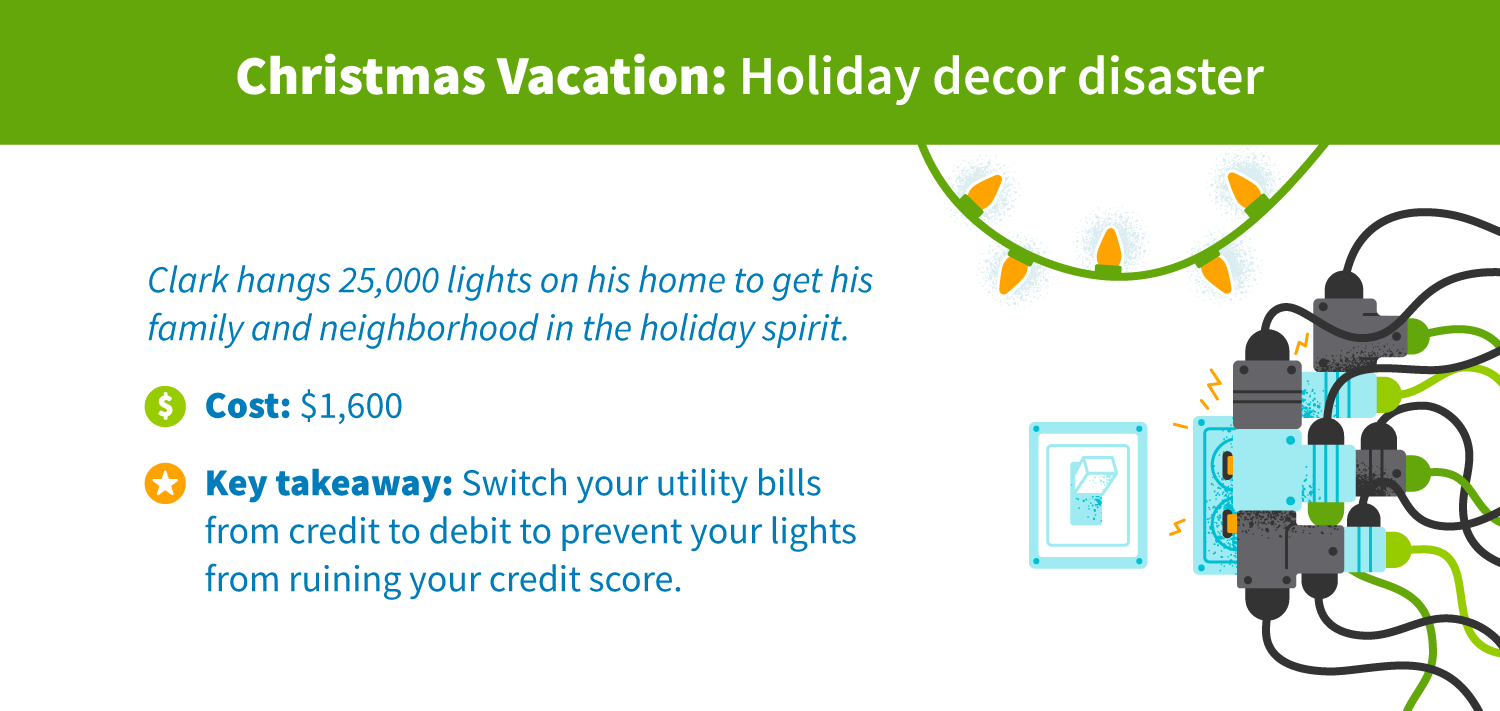
Disclosure regarding our editorial content standards.
The holidays are a time to be with loved ones, sipping on eggnog and relaxing at the end of a busy year. Part of this relaxation includes indulging in classic holiday movies, shows and songs that characterize the season. Year after year, families and friends enjoy the hijinks of the Griswold family, cringe at the injuries inflicted on the Wet Bandits and let their hearts grow three times bigger alongside the Grinch.
Though some of these movie moments shouldn’t be recreated in real life (particularly any of the traps set in “Home Alone”), we wanted to analyze just how much these iconic moments could cost if they actually took place. Even if you’re just curious how much these moments would cost, it’s important to learn some valuable financial lessons from these lovable characters.
Especially around the holidays, it can be easy to overspend, be blinded by the deals and purchase things you don’t need. These financial decisions can have some long-lasting implications, like significant credit card debt that can in turn impact your credit score. The good news is that practicing a few mindful habits can help you stay under budget and out of debt during the holiday season!
Read on for more information on how much iconic pop culture holiday moments would cost, or skip down to the infographic for these moments at a glance. Above all, take a cue from Charlie Brown and remember the real meaning of Christmas: spending time with your loved ones, not racking up debt.
1. “Elf”: Buddy’s syrup, spaghetti and candy breakfast
In this 2003 holiday classic, Buddy the Elf learns he isn’t an elf after all—he’s actually a human that’s been living and working in Santa’s workshop for the better part of 30 years. Determined to meet his human father and figure out his background, Buddy journeys from the North Pole to New York City to find his dad, a big-time executive at a children’s book publishing company.
Buddy’s father reluctantly invites him to stay and meet his stepmother and brother, taken aback by Buddy’s childlike, naive demeanor. Buddy makes himself right at home, decorating their apartment for the holidays and introducing his new family to a typical elf diet. To share his favorite foods, Buddy prepares a spaghetti breakfast for everyone topped with maple and chocolate syrups, M&Ms, mini marshmallows, sprinkles and Pop-Tarts.
Cost: Though no nutritionist or dentist would approve of this meal, recreating Buddy’s breakfast is relatively easy and cost-effective. You’ll need:
- One package of spaghetti: $1
- Quality maple syrup: $7
- Chocolate syrup: $3
- One packet of regular M&Ms: $2
- A bag of mini marshmallows: $2
- Rainbow sprinkles: $2
- One box of chocolate fudge Pop-Tarts: $3
Total cost: $20
Key takeaway: It can be tempting to splurge on food and sweets around the holidays, especially if you’ll be hosting kids. Be sure you’re budgeting appropriately, and resist the temptation to put the costs on an emergency credit card to worry about later.
2. “A Charlie Brown Christmas”: Charlie’s tiny tree
Charlie, overcome with holiday blues, is tasked with finding a real Christmas tree to set the mood for the annual holiday play at school. Though Lucy and his friends request a “great, big, shiny aluminum tree … maybe painted pink,” he returns with a small sapling that was the only living tree in the lot. Though he believes it will look the part once decorated, his friends scorn him and his tree.
Realizing his friends’ judgement is clouded with the materialism of the season, Charlie is determined to decorate the tree and show how perfect it is for the play. However, once one heavy ornament causes the tree to bend, Charlie grows discouraged and walks away from the project altogether. However, realizing they may have been too hard on him, his friends return:
First Linus, wrapping his blanket around the base of the tree, then the rest of the gang, bringing borrowed lights and decor from Snoopy’s doghouse. Charlie comes back and sees his little tree, all dressed up for the holidays, and his friends greet him with “Merry Christmas, Charlie Brown!”
Cost: To get your very own Charlie Brown tree, you’ll need:
- A mini Christmas tree, real or fake: $10
- Collection of mini ornaments and a star: $10
- Blanket for tree base: $10
Total cost: $30
Key takeaway: Remember that the holiday season isn’t about racking up credit card debt to buy everyone extraordinary presents—it’s about who you spend the season with.
3. “Love, Actually”: Mark’s giant cue cards
An early 2000s holiday classic, this film is composed of the stories of different Londoners’ lives as they prepare for Christmas. One of these stories follows Juliet, Peter and Mark—a recently married couple and their longtime friend. Juliet learns that Mark has feelings for her at the same time she realizes being married to Peter isn’t what she thought it would be.
On Christmas Eve, Juliet answers a knock on the door to find Mark on the front stoop, holding cue cards and a boom box. He plays carols on a CD so as to not tip off Peter, and holds up a number of cue cards to tell Juliet that he loves her, without expectation of reciprocation. As he’s leaving, Juliet chases him to give him a kiss.
Cost:
- Permanent marker: $1
- Carols CD: $8
- 13 poster board cue cards: $13 (at $1/each)
- CD player: $40
Total cost: $62
Key takeaway: As far as romantic gestures go, this is a pretty grand one while being cost-friendly. If you’re looking to recreate the iconic “to me, you are perfect” cue cards on even more of a budget, try index cards—or maybe just a card.
4. “Home Alone”: Kevin’s traps to catch the Wet Bandits
John Hughes’s classic Christmas comedy focuses on Kevin McCallister, a frustrated eight-year-old who’s about to fly to Paris with his entire extended family for the holidays. Accidentally left behind by his parents in the chaos of catching their flight, Kevin finds his home under attack by the Wet Bandits—two home burglars who have been eyeing the house for weeks.
Kevin overhears their plans to break in and steal his family’s belongings and knows it’s up to him to defend his house. Rigging up a series of booby traps throughout the home with items like ornaments, tar, fire extinguishers, nails, paint and buckets, Kevin successfully foils the Wet Bandits’ plot. Minus a few teeth and their dignity, the Bandits are apprehended by the police thanks to Kevin.
Cost: To recreate the traps Kevin sets up in his home, you’ll need:
- Caulking glue: $3
- Bag of feathers: $3
- Plastic wrap: $5
- Box of nails: $5
- Utility wire: $5
- Rope: $6
- Iron: $10
- Two paint cans: $10 (at $5/each)
- Electric BBQ starter: $10
- Box of ornaments: $20
- Blowtorch: $20
- Box of Micro Machines: $20
- Standing fan: $20
- BB gun: $25
- Bucket of tar: $40
Total cost: Though Kevin likely used materials from around his family home, buying materials to recreate all of his booby traps would cost around $202.
Key takeaway: It’s probably best to invest in a reliable security system for your home, and insurance for your belongings and credit cards, instead of relying on your eight-year-old to keep break-ins from happening with homemade traps. You can also use these items to do some home improvement projects instead of trapping two burglars.

5. “A Christmas Story”: Ralphie’s Red Ryder BB gun and broken glasses
In the classic Cleveland-set holiday movie “A Christmas Story,” all Ralphie Parker wants for Christmas in 1983 is a Red Ryder carbine action 200-shot range model air rifle. Whenever he shares his wish with the adults in his life, from his mom to a department store Santa Claus, he’s issued the same warning: “You’ll shoot your eye out, kid!”
Luckily for him, on Christmas Day, his last gift is just what he’d been hoping for: the air gun of his dreams. When setting up his new toy, a BB ricochets off a metal target and causes Ralphie’s glasses to fall off. Thinking that he had indeed shot his eye out while looking for his specs, he accidentally steps on them, causing them to break.
To avoid his new possession being returned to the store, he lies to his mother and says a falling icicle broke his glasses.
Cost: To recreate Ralphie’s exact scenario, broken glasses and all, you’ll need:
- Same model BB gun as Ralphie: $30
- New prescription frames and lenses: Average about $196 per pair
Total cost: $230
Key takeaway: If you gift or receive an air gun for the holidays, preemptively invest in some protective eyewear (like goggles) to accompany it in order to avoid costly medical bills, emergency room visits or eye surgeries.
6. “A Christmas Carol”: Scrooge’s gifts to the Cratchit family
In Charles Dickens’s classic Christmas tale, Ebenezer Scrooge is a penny-pinching man despite being wealthy and hoarding money for decades. After being visited on Christmas Eve by the Ghosts of Christmases Past, Present and Future, he is issued a clear warning: Change his hateful, miserly ways, or die alone with no friends or family to miss him.
He wakes up on Christmas Morning a changed man, and decides to pay a visit to his secretary Bob Cratchit, whom he fired the night before. Bringing food, gifts and toys for Bob’s six children, including his sickly son Tiny Tim, Scrooge promotes Bob to a partner at his job and promises to take care of him and his family for the rest of his days. Overcome with emotion, Tiny Tim declares “God bless us, every one!”
Cost: To recreate Scrooge’s change of heart, you’ll need:
- Toys for six children: $200
- Roasted goose Christmas dinner for eight: $200
Total cost: $400
Key takeaway: Remember to be generous this holiday season, whether or not you’re visited by three spirits in the night. Factor in some charitable donations to your holiday budget, or “adopt” a child and their wish list through a local program—and as a bonus, these charitable donations are usually tax-deductible.
7. “The Office”: Michael’s classy Christmas
In the popular NBC cringe comedy, boss Michael Scott is known for pulling out all the stops to impress a new boss, new girlfriend or new friend. It’s no surprise when he cancels the branch’s modest cookie-and-sweater holiday gathering for something much more extravagant when he receives word that his former love interest and HR representative, Holly, is returning to the Scranton branch of Dunder Mifflin.
When Holly returns, she’s greeted by a “classy Christmas” unlike anything the Scranton branch has seen before. A single jazz bass player, twinkly lights, a custom-fitted Santa-themed cigar jacket and hat and more add to the classy atmosphere of Dunder Mifflin’s holiday party—all paid for out of Michael’s own pocket.
Cost: To throw your very own classy Christmas, you’ll need the following:
- Christmas lights: $4 per 20 ft. string
- Bassist for one work day: $75/hour for eight hours
- Real Christmas tree: $80
- Decorations: $80
- Food and drink: $200
- Santa cigar jacket and hat: $100
Total cost: Impressing Holly cost Michael around $1,100 because he paid for everything out of pocket.
Key takeaway: As badly as you may want to impress your crush, it’s best to leave the holiday party (and budgeting) to the Party Planning Committee instead of planning and paying for it yourself—especially if you’re like Michael and have declared bankruptcy due to some poor financial decisions.
8. “National Lampoon’s Christmas Vacation”: Clark Griswold’s holiday lights display
One of the most iconic holiday movies, this 1989 classic focuses on the highs and many, many lows of the holiday season for the Griswold family. The patriarch, Clark, is determined to have a “fun, old-fashioned family Christmas,” whatever it takes. To get his family into the holiday spirit, Clark sets out to decorate his house’s exterior with 25,000 twinkle lights.
Despite the many mishaps that occur while he’s hanging them, the lights go up on the house—though they fail to turn on, as Clark has mistakenly wired them through the garage’s light switch. When he fixes his error and turns them on, the lights cause a citywide power outage and practically blind the Griswold’s neighbors.
Cost: At the national average of about 12 cents per kWh, with the lights on for seven hours per night from Thanksgiving to New Year’s, here’s the approximate breakdown:
- Christmas tree: $17
- Christmas accessories requiring electricity: $9
- Icicle lights: $686
- String lights: $378
- Tree lights: $529
Total cost: Recreating the Griswold decorations would cost you just over $1,600.
Key takeaway: Holiday decorations can eat away at your wallet (and electricity bill). If your bills are on auto-pay, check carefully around the holidays to see if your bill is higher than usual, and consider whether you want to put that utility on your debit card instead of your credit card to keep your lights from affecting your score.

9. “The Grinch”: Realistic Santa outfit and sleigh
One of Dr. Seuss’s many classic creations, the titular character in “How the Grinch Stole Christmas” lives high above the Christmas-obsessed town of Whoville with only his dog, Max. He hates everything about Christmas and the Whos, though the reason is unclear—it’s speculated his shoes are too tight, or his heart may be too small.
Driven mad by their obsession with the holiday, the Grinch formulates a plan to “steal” Christmas, including their decor, instruments, meal and, most significantly of all, gifts.
In order to steal Christmas undetected, he stitches together a Santa suit, hat and beard and assembles a sleigh, even putting a reindeer horn on the top of Max’s head. His attempts to steal Christmas are thwarted by the Whos celebrating despite their lack of gifts or decor, and the Grinch learns that Christmas isn’t about what you have—it’s about your holiday spirit.
Cost: If you’re feeling Grinchy about the holidays and want to take a page from Dr. Seuss, you’ll need:
- Dog antler or headband: $15
- Santa sack for gifts: $20
- Santa costume: $70
- Sleigh: $1,500
Total cost: $1,605
Key takeaway: Invest in some free holiday cheer instead of expensive decorations or meaningless gifts, and remember to include those who may not have anyone to spend the season with in your plans.
10. “Christmas with the Kranks”: Holiday Caribbean cruise
After seeing their daughter off on a Peace Corps mission, Luther and Nora Krank are hit with empty-nest syndrome. Luther does the math and discovers that altogether, the Kranks spent $6,132 on Christmas the previous year—including decor, presents, food and entertainment. Not looking forward to celebrating the holiday season without their daughter, the Kranks decide to take what money they would have spent on Christmas and treat themselves to a 10-day Caribbean cruise over the holiday instead.
The two decide to completely boycott the holiday, without even decorating their home. The day they’re supposed to leave for their trip, their daughter calls with a new fiance in tow and asks what time their annual Christmas party is—leaving the parents with 12 hours to coordinate a holiday party from scratch. Pulling it together with minutes to spare, the Kranks realize that even though they would have spent this holiday sans children, that doesn’t mean their holiday would have been ruined.
Cost: If you also want to avoid the holiday altogether, a 10-day Caribbean cruise for two will cost around $3,000, not including airfare.
Key takeaway: The holiday season can get expensive quickly, especially if you have children or a big family to shop for. To avoid credit fiascos or overspending, sit down with your family or spouse to create a realistic budget you can all stick to, without forgoing any Christmas traditions.
11. “The Holiday”: Long vacations in England and Los Angeles
This modern-day tale of two cities focuses on Iris, a Londoner who is still in love with her ex-boyfriend, who cheated on her; and Amanda, a Los Angeles producer who discovers her live-in boyfriend was unfaithful just days before Christmas. Both desperate to get away for the holidays, the two women meet on a home-swap website and agree to trade places for Christmas.
The two take an extended holiday in each other’s homes, Iris in sunny Los Angeles and Amanda in a wintry village outside of London. Though Amanda has a harder time adjusting than Iris, the two enjoy time alone over the holidays—and find love when they’re least looking for it.
Cost: If you also want to get away from your home for the holidays, here’s what recreating both Iris and Amanda’s journeys would cost you:
- Economy round-trip ticket to Los Angeles: $900
- First-class round-trip ticket to London: $6,000
Key takeaway: Especially when booking last-minute travel, it can be tempting to put your flight on your credit card and worry about it later. Be sure you’re making smart financial decisions for travel during the holiday season, including adding on travel insurance.
12. “The 12 Days of Christmas”: 12 gifts
One of the best-known—not to mention longest—Christmas carols originated around the 1780s. The verses count down what the singer’s true love will receive each day on the 12 days leading up to Christmas.
Starting with a partridge in a pear tree, the gifts include turtle doves, golden rings, milkmaids, dancing ladies, drummers drumming and more.
Cost: To recreate the 12 gifts mentioned in the song, you’ll need:
- Partridge: $20
- Pear tree: $210
- Two turtle doves: $300 (at $150/each)
- Three French hens: $180 (at $60/each)
- Four calling birds: $600 (at $150/each)
- Five golden rings: $825 (at $165/each)
- Six geese a-laying: $420 (at $70/each)
- Seven swans a-swimming: $13,125 (at $1,875/each)
- Eight maids a-milking: $58 (at $7.50/hour)
- Nine ladies dancing: $7,550 (at $838/each)
- Ten lords a-leaping: $10,000 (at $1,000/each)
- 11 pipers piping: $2,750 (at $250/each)
- 12 drummers drumming: $2,970 (at $248/each)
Total cost: $38,828
Key takeaway: Unless your true love lives on a farm where they can accommodate around 20 different birds, it’s best to plan and budget for some smaller gifts for your significant other—as tempting as it can be to spoil them with extravagant presents.

13. “Miracle on 34th Street”: Susan’s dream house
When smart-yet-cynical six-year-old Susan meets Kris, a department store Santa who claims he’s the real thing, she doubts his claims that he’s actually Kris Kringle. Raised to be practical, not believe in Santa Claus or have an imagination, Susan gets closer to Kris and begins to believe that maybe he is the real thing. To test Kris, Susan requests two things for Christmas: a house, and for her lawyer neighbor, Bill, to marry her mother, Karen.
Kris’s employers and doctors, concerned for his mental state, recommend he be committed due to his delusions that he’s Santa. At his commitment hearing, the Post Office delivers all of Santa’s letters to the courtroom, proving definitively that Kris is in fact Santa. Susan is overjoyed, until she realizes one thing: He hasn’t gotten her a house.
On the drive back to their home, Susan spots the house she wished for and runs inside after seeing it has the swing she asked for. Bill and Karen follow her and see the cane Kris always walked with tucked in the corner.
Cost: On average, a home in New York state costs around $340,000.
Key takeaway: Buying a house with or without help from Mr. Claus is a big deal and will have an impact on your credit for years to come. Before you sign a mortgage, make sure your finances and credit score are in order.
As our favorite pop culture moments have demonstrated, it can be easy to spend way too much around the holidays. As tempting as it can be to spoil our loved ones and buy tons of holiday decor to make the season merry and bright, it’s important to follow a budget and make careful purchasing decisions.
If the holiday season ends and your credit score has shrunk smaller than the Grinch’s heart, don’t worry—we have tips on how to fix your credit, as well as advice on managing your credit that even the biggest Scrooges can learn from.







